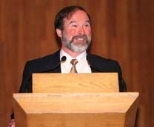The Class of 2004 was welcomed to MIT on Thursday with a tantalizing glimpse of state-of-the-art brain research from Nancy Kanwisher, associate professor of brain and cognitive sciences; President Charles Vest's overview of the privileges of being an MIT student; a reassuring welcome from Dean for Undergraduate Education Robert P. Redwine; some useful information on finding public restrooms from Peter A. Shulman, a senior in mathematics who is president of the Undergraduate Association; and a slapstick skit based on "Who Wants To Be a Millionaire?" staged by the four Orientation coordinators.
"Freshman year is not a rehearsal. This is as real as it gets. The next four years aren't preparation or training for your career. Your career has already begun," Dr. Vest told the incoming class. He urged students to take leadership roles and use their newfound knowledge and skills to help solve world problems. "The world needs people who can commit simultaneously to incremental improvement and fundamental change," he said.
Professor Kanwisher gave new meaning to the expression "seeing in the mind's eye" when she described her latest research. Her work, which uses functional magnetic resonance imaging to detect the precise location of brain activity in response to visual stimuli, shows that even when people imagine a scene or a face, they are using the same parts of the brain that react when they see scenes and faces in reality.
Even though thinking about a celebrity's face or picturing the front of your house is a very different action from actually having the image fall on your retina, Professor Kanwisher's group showed that the same parts of the brain -- very specific areas that react strongly to spaces and faces -- also were active when subjects heard the names of well-known people such as Bill Clinton or Woody Allen, or places such as Killian Court.
"We use some of the same brain machinery when we actually see and when we simply imagine," said Professor Kanwisher, who drew giggles and gasps from her audience when she showed an enormous picture of her own brain. She then inflated the image like a balloon to show how researchers try to "see" the inside of the brain's many folds, and rotated it on the screen.
Professor Kanwisher, who graduated from MIT in 1980, recalled that she sometimes got overwhelmed as an undergraduate, as did many of her classmates. "This is normal," she told the incoming class. "It's tough going from being the star of your class to being a run-of-the-mill, struggling MIT student."
Dean Redwine urged the students to "be open and adventurous" and take advantage of the "incredible opportunity of being in a community of people and ideas of the quality and variety of a kind you will probably never see again."
Mr. Schulman gave a tongue-in-cheek guide to MIT restrooms and pointed out some of the "intracacies of the restroom system," which involves knowing, among other things, that male and female restrooms are on alternate floors in the buildings connected by the Infinite Corridor.
A version of this article appeared in MIT Tech Talk on August 30, 2000.







